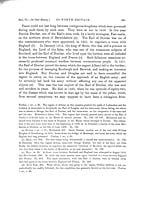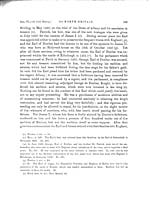Volume 3
(274) Page 262
Download files
Individual page:
Thumbnail gallery: Grid view | List view

262 with an attendant dysentery (e). He married Christian, the daughter of Sir William Seton, who brought him two sons and six daughters (f). George, Earl of Dunbar, who thus died in 1420, though the genealogists suppose him to have deceased in 1416, was certainly an eminent noble, who involved himself in misery and ruined his affairs by two imprudent acts; the marrying of his daughter to the heir-apparent of the throne while under age; and his own revolt against his sovereign, who had not injured him, when he found himself overreached by more unprincipled politicians. When the second George, Earl of Dunbar, thus succeeded his father, he must have been aged almost fifty (g). In 1423, and in 1424, the Earl and his brothers were much employed in negotiating the freedom of James I. (h). The Earl of Dunbar had the honour to meet the king at Durham on his return to Scotland (i). The Earl, attending his coronation on the 21st of May 1424, was one of those eminent men who were knighted on that joyous occasion (k). He was one of the conservators of the seven years truce which James concluded at Durham (l). Yet was he arrested, at the parliament of Perth, on the 21st of March 1425, with Murdoch, Duke of Albany, Archibald, Earl of Douglas, William, Earl of Angus, and twenty persons of less rank (m). The three Earls must have been soon liberated, as they sat with others in the parliament of (e) Fordun, 1. xv., c. 32. As George, Earl of Dunbar, was upwards of thirty when he received the earldom from his father in 1369, he must have held the earldom fifty-two years, and must have been upwards of eighty-two at his death. (/) Dougl. Peer., 441. Christian, the Countess, is mentioned in the contract between Henry IV. and the Earl of Dunbar. Rym., viii., 153. Five of their sons, George, Gavin, Colin, Patrick, John, are mentioned by a charter of Robert II. in 1390. Robertson's Index, 126. David, their sixth son, is mentioned in Rym., x., 292, as a prisoner during 1423. David Dunbar had the honour to fall in defending, with equal spirit and loyalty, James I. when he was assassinated. Fordun, 1. xiv., c. 27. The two daughters of the Earl and Countess were Janet and Elizabeth. It is curious to remark that Douglas and the other peerage writers have forgotten that this Earl of Dunbar had a daughter Elizabeth, who, as she had been affianced to the Duke of Rothesay, was called the Duchess of Rothesay by Henry IV., occasioned the revolt of her father and the ruin of his family. (g) In 1390, he obtained from Robert III. a grant to him as heir of the Earl of Dunbar. of his ward, relief, and marriage, for the earldom of March and the lordship of Annandale. Robertson's Index, 126. He appears in various public transactions during the last twenty years of his father's devious life. He seems to have held his father's castle of Cockburnspath, during his father's residence in England, from 1400 to 1409. In 1411, he acted as a commissioner for liberating the regent's son; and in 1415, he again was employed to obtain the freedom of the same person. (h) Rym., x. 286, 299-301-308-9, 327-8. (i) Ib., 309. (k) Fordun, 1. xiv., c. 2 ; Abereromby, ii., 269. (l) Rym., x. 382. (m) Fordun, 1. xvi., c. 10.
Set display mode to:
![]() Universal Viewer |
Universal Viewer | ![]() Mirador |
Large image | Transcription
Mirador |
Large image | Transcription
Images and transcriptions on this page, including medium image downloads, may be used under the Creative Commons Attribution 4.0 International Licence unless otherwise stated. ![]()
| Caledonia, or, An account, historical and topographic of North Britain from the most ancient to the present times > Volume 3 > (274) Page 262 |
|---|
| Permanent URL | https://digital.nls.uk/74528622 |
|---|---|
| Description | Vol. III. |
|---|---|
| Attribution and copyright: |
|

